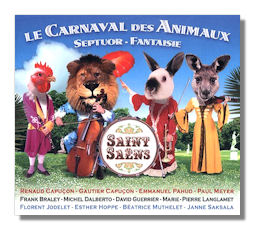
The Internet's Premier Classical Music Source
Related Links
- Saint-Saëns Reviews
- Latest Reviews
- More Reviews
-
By Composer
-
Collections
DVD & Blu-ray
Books
Concert Reviews
Articles/Interviews
Software
Audio
Search Amazon
Recommended Links
Site News
 CD Review
CD Review
Camille Saint-Saëns

- Carnival of the animals
- Fantasy for violin and harp
- Romance for cello and piano
- Prayer for cello and piano
- Septet
- Samson and Dalila: Mon coeur s'ouvre à ta voix (arr. Papin)
Renaud Capuçon, Esther Hoppe, violin
Béatrice Muthelet, viola
Gautier Capuçon, cello
Janne Saksala, double bass
Frank Braley, Michel Dalberto, piano
Marie-Pierre Langlamet, harp
Emmanuel Pahud, flute
Paul Meyer, clarinet
David Guerrier, trumpet
Florent Jodelet, xylophone
Virgin Classics 5 45603 2 DDD 62:59
Camille Saint-Saëns wrote a lot of chamber music. The one work he is remembered for in that genre, however, is Le Carnaval des animaux, and that usually in a version for full orchestra… sometimes with narration! (The composer probably is turning over in his grave from sheer mortification.) Some of France's best young musicians have been assembled to do poor old Camille justice. Not only is Carnaval restored to an ensemble of eleven players, some of the composer's more obscure chamber works are given an airing as well.
The musicians put Saint-Saëns's menagerie through the Atkins Diet, if you will; here's a performance where the lines are sharp and clean, without huffing and puffing as the technical hurdles are negotiated. If anything, these zookeepers overdo it, broadening the jokes beyond what the composer might have sanctioned. The "Long-eared Personages" are made more ass-like through the exaggerated use of microtones, and the duo-"Pianists" are incapable even of playing their scale exercises in synchrony. This might be funny in concert, and it is amusing the first time one hears it on CD, but it eventually becomes tiring because it is so obvious. The quieter numbers – "Aquarium," "Cuckoo in the depths of the forest," and, most famously, "The Swan" – are done with a minimum of sentimentality. All in all, this is a "low fat" Carnaval – perfect for listeners who are watching their weight, musically speaking.
The Septet is scored for the surprising combination of piano, string quintet, and trumpet. This work, written for an ensemble of amateurs, is almost as lightweight as Carnaval. With its insouciant swagger, the trumpet is a comic opera hero in this work. Another substantial and surprisingly scored work is the Fantasy for violin and harp. It's a fantasy, alright – Saint-Saëns jumps from one mood to the next, giving the performers barely a moment to shift gears. The other three works are performed by cello and piano, although the aria from Samson and Dalila is an arrangement, of course, Prayer was meant to be accompanied by the organ, and the Romance was written for horn and orchestra. And so, Camille Saint-Saëns might have recognized only Carnaval, the Fantasy, and the Septet as his own childen!
As implied above, the performances are technically accomplished but not very warm. There's nothing old-fashioned about this musicianship. The composer's admirers will want this CD for its unusual repertoire. The engineering is ideal, and I liked the fanciful artwork and the attractive Digipak packaging.
Copyright © 2004, Raymond Tuttle




















